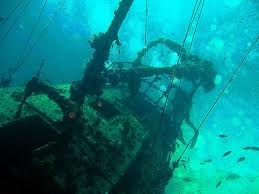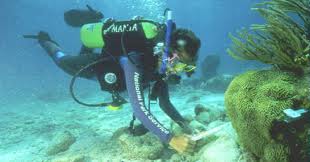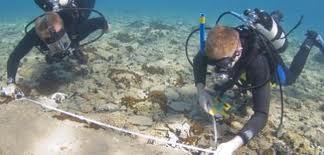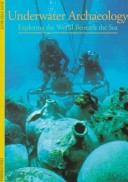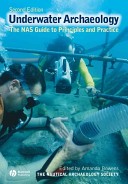- Latest Archaeology Updates
- Importance and applicability
- Famous Archaeologists
- Museums Collections
- Site Map
- World Heritage Sites
- World History Monuments
- Archaeological Organizations
- World Atlas of Archaeology
- Forensic Investigation and Geophysics
- Contact Us
- Movies based on Archaeology
- Frequently Asked Questions
- Archaeological discoveries
- Tell a Friend
- Archaeological Abbreviations
- Gallery Collections
- Famous-Museums site map
- Famous-archaeologists site map
- Archaeological Monuments site map
Underwater Archaeology is that branch of the regulation and science of Archaeology that is practiced under water, either by archaeologists outfitted with breathing equipment or by the remote control of machines. Strictly, this means archaeology under water, which is the main discipline of maritime archaeology
Underwater archaeology is considered as a branch of maritime archaeology (the archaeology of aquatic vessels and associated infrastructure), though not exclusively: underwater excavation techniques and methodology can also be applied in the study of sunken settlement and committal sites, for instance. underwater or maritime archaeology does not essentially deal with wrecks, even if that is the part scuba divers more often deal with. Underwater archaeology is often complementary to archaeological research on terrestrial sites because often the two are linked by many and various elements including geographic, social, political, economic and other considerations. As a result a study of an archaeological landscape can involve a multidisciplinary approach requiring the inclusion of many specialists from a variety of disciplines including prehistory, historical archaeology, maritime archaeology, anthropology.
Shipwrecks, such as The Mary Rose, can also be important for archaeology because they can form a variety of accidental time capsule, preserving a collection of human artifacts at the moment in time when the ship was lost.Sometimes it is not the wrecking of the ship that is important, but the fact that we have access to the remains of it, especially where the vessel was of major importance and significance in the history of science and engineering, due to being the first of its type of vessel.
The growth of submarines, for example, can be traced via underwater archaeological research, via the Hunley which was the first submarine to sink an enemy ship, the Resurgam II, the first powered submarine, and Holland 5, which provides insight into the development of submarines in the British Navy.
A working platform for underwater archeology requirements to be prepared to provide for the delivery of air for example, recompression and medical facilities, or specialist remote sensing equipment, analysis of archaeological results, support for activities being undertaken in the water, storage of supplies, facilities for conservation for any items recovered from the water, as well as accommodation for workers.
In addition it can be complicated to allow access to the results of the archaeological research as underwater sites do not provide good outreach possibilities or access for the general public.
Although particular techniques and tools have been developed to address the challenges of working under water, the archaeological goals and process are fundamentally the same as in any other context. Investigating an underwater site however, is likely to take longer and be more costly than an equivalent terrestrial one.
- DISCOVERY
- EXCAVATION AND RESTORATION
- BRANCHES OF SCIENCE
- CONSERVATION
- DISCOVERY
- An integrated system of navigation and prospecting to detect shipwrecks
- The robotic craft Lagune to excavate in areas that are difficult to access
- The submersibles : the Remora, the saucer Cyana, the Nautile for the exploration of shipwrecks at great depths
- Saturation diving, for the exploration of shipwrecks at depths between 60 and 80 metres
- EXCAVATION AND RESTORATION
- Andre Malraux, the DRASSM's Research Vessel of the Future
- Techniques of undersea excavation ...from the clearing of the ship ... to the synopsis of data
- Virtual excavation, computer-assisted excavation
- BRANCHES OF SCIENCE
- Nuclear physics allows dating of organic matter
- Dendrochronology allows dating of ship's structure
- Radiography provides information on corroded metals
- CONSERVATION
Underwater archaeology: exploring the world beneath the sea - Jean-Yves Blot - 1996 p>
Underwater archaeology: the NAS guide to principles and practice - Amanda Bowens, Nautical Archaeology Society - 2009
International handbook of underwater archaeology - Carol Ruppe, Jan Barstad - 2002.
- Underwater Archaeology in Wiki Underwater archaeology is archaeology practised underwater. As with all other branches of archaeology it evolved from its roots in pre-history and in the classical era to include sites from the historical and industrial eras. Its acceptance has been a relatively late development due to the difficulties of accessing and working underwater sites.
- underwaterarchaeology.com :underwaterarchaeology Resources and Information
- principles of underwater archaeology :principles of underwater archaeology as professional archaeologists and this standardisation of training is a fundamental basic that creates a safe and enjoyable diving and project environment, with all participants working to one standard goal.
-
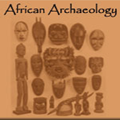 African Archaeology Africa has the longest record of human activity of any part of the world and along with its geographical extent; it contains an enormous archaeological resource. Scholars have studied Egyptology for centuries but archaeologists have only paid serious attention to the rest of the continent in more recent times.
African Archaeology Africa has the longest record of human activity of any part of the world and along with its geographical extent; it contains an enormous archaeological resource. Scholars have studied Egyptology for centuries but archaeologists have only paid serious attention to the rest of the continent in more recent times. -
 American Archaeology Archaeology of the Americas is the learning of the archaeology of North America, Central America (or Mesoamerica), South America and the Caribbean, which is to say, the pre-history and Pre-Columbian history of Native American peoples.
American Archaeology Archaeology of the Americas is the learning of the archaeology of North America, Central America (or Mesoamerica), South America and the Caribbean, which is to say, the pre-history and Pre-Columbian history of Native American peoples. -
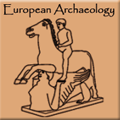 European Archaeology In terms of area, Europe is the world's second smallest continent, with an area of 10,400,000 kmē (4,000,000 square miles), making it slightly larger than Australia.
European Archaeology In terms of area, Europe is the world's second smallest continent, with an area of 10,400,000 kmē (4,000,000 square miles), making it slightly larger than Australia. -
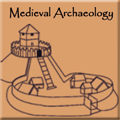 Medival archaeology The period covers the commotion caused by the fall of the Medival archaeology Roman Empire and cultures such as the Vikings, Saxons and Franks.
Medival archaeology The period covers the commotion caused by the fall of the Medival archaeology Roman Empire and cultures such as the Vikings, Saxons and Franks. -
 Near Eastern Archaeology Near Eastern Archaeology is a wide generalised application, and is divided into further regional sub-branches, the archaeology of modern states in the region or along broad thematic lines.
Near Eastern Archaeology Near Eastern Archaeology is a wide generalised application, and is divided into further regional sub-branches, the archaeology of modern states in the region or along broad thematic lines. -
 Post Medieval Archaeology The Post Medieval Archaeology is considered as a bi-annual journal study of the material evidence of European society. This period saw the conversion of medieval to industrial society.
Post Medieval Archaeology The Post Medieval Archaeology is considered as a bi-annual journal study of the material evidence of European society. This period saw the conversion of medieval to industrial society. -
 Modern Archaeology In contrast to the antiquarianism of classical archaeology, anthropological archaeology today is concerned with culture history (i.e., the chronology of events and cultural traditions) and the explanation of cultural processes.
Modern Archaeology In contrast to the antiquarianism of classical archaeology, anthropological archaeology today is concerned with culture history (i.e., the chronology of events and cultural traditions) and the explanation of cultural processes.


